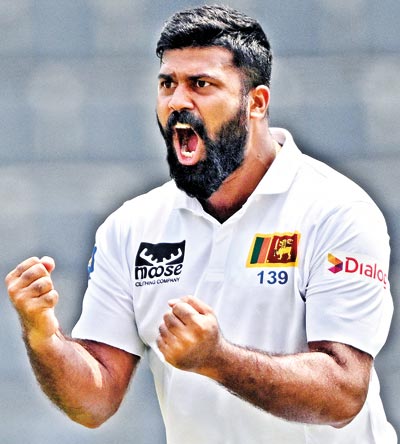Happy with performance, but fitness is paramount – Chief Selector Tharanga
 Before finalising the ODI squad for the three-match series against Bangladesh, national selectors were in a dilemma whether or not to pick Lahiru Kumara. Their concern stemmed from Kumara’s soaring skin-fold levels, which raised doubts about his fitness and increased his susceptibility to injuries. The reading was well over 120–much more than the required 85, indicating significant room for improvement in his fitness.
Before finalising the ODI squad for the three-match series against Bangladesh, national selectors were in a dilemma whether or not to pick Lahiru Kumara. Their concern stemmed from Kumara’s soaring skin-fold levels, which raised doubts about his fitness and increased his susceptibility to injuries. The reading was well over 120–much more than the required 85, indicating significant room for improvement in his fitness.However, Kumara’s performances at the domestic level presented a compelling case for his selection. He was the leading wicket-taker (9 in 4 games) in the National Super League limited over tournament. His raw skills and potential to make a significant impact on the field could not be overlooked.
In order to address the outstanding issue, however, the selectors decided to present Kumara with two options. The first was for him to dedicate his time to improving his fitness levels and earning his place in the squad while the other required him to accept a sizable pay cut to join the team for the series. Kumara opted for the latter as he decided to prove his worth by contributing to the team’s success.
As the series unfolded, Kumara emerged as a potent force with the ball, displaying skills and ability that silenced his doubters. He ended the series with a remarkable tally of 11 wickets, including a best of 4 for 50 at 12.63, the leading average in the series. His contributions played a crucial role in Sri Lanka’s easy 2-0 thrashing of the Tigers in their own backyard in the Tests.
His pace, accuracy, and ability to generate bounce troubled the Bangladeshi batsmen throughout. His impact on the field was undeniable, and it was clear he had proven his worth despite the fitness concerns that initially surrounded him.
“Extremely happy with how he performed in the series, but saying that, he needs to work hard on his fitness,” said Chief selector Upul Tharanga.
“We simply couldn’t ignore him as he has done well at the domestic level, this is why we decided to impose a significant pay cut on his match fees but we cannot do this all the time. We have given him targets and he needs to work with trainers to meet those targets in order to be selected to the team.”
 Kumara was in the three-man seam attack that Sri Lanka deployed during the series. Not often we have seen Sri Lanka play three genuine seamers in the subcontinent and, although many had their reservations about the move, it proved a masterstroke by the team management.
Kumara was in the three-man seam attack that Sri Lanka deployed during the series. Not often we have seen Sri Lanka play three genuine seamers in the subcontinent and, although many had their reservations about the move, it proved a masterstroke by the team management.
In the first Test match in Sylhet, the seam combination of Lahiru Kumara, Kasun Rajitha, and Vishwa Fernando picked up all 20 wickets as Sri Lanka beat Bangladesh by 328 runs. Their collective effort provided a solid foundation for Sri Lanka to secure a victory and take an early lead in the series. Despite an injury to Kasun Rajitha, who had bowled his heart out in the first game, claiming eight wickers, Sri Lankan seamers made a powerful statement as Kumara, Vishwa and Asitha Fernando picked up 13 wickets in the second match to sweep the series.
Vishwa ended up with 10 wickets while Rajitha had eight scalps in just two innings and Asitha returned with four wickets in one game.
“They did an exceptional job,” the former Sri Lankan skipper commended the seamers.
“We have seen what they are capable of in tracks that offer little assistance to the spinners. They used the old ball very skillfully and that was good. What is now required is for them to work hard on their fitness and remain injury free.”
The success of the seam attack not only reflected the talent and skill of the individual bowlers, but also the strategic approach the team coaching unit has followed to build a strong squad of seamers. Apart from the trio, Dushmantha Chameera, Dilshan Madushanka, Matheesha Pathirana, Nuwan Thushara and Binura Fernando add to Sri Lanka’s seam stocks, even though one area that all of them need to improve is fitness.
“As a captain, I like to play a more aggressive brand of cricket, and go with fast bowlers. That’s why we went with three quicks. Our bowlers don’t need to have grass on the track to get wickets, and they proved that,” Sri Lanka skipper Dhananjaya de Silva told reporters after the series.
Dhananjaya acknowledged that getting wickets on such pitches was a challenging task. The hot weather and lack of life in the pitch required the bowlers to work exceptionally hard.
“To get a wicket is really hard here. It’s very hot with the sun, and there was not a lot of life in the pitch, so we had to work very hard. Because of our batters’ talents, we were able to have a massive first-innings lead. That was advantageous to our bowlers.”
Since Chris Silverwood took over as Sri Lanka’s head coach in 2022, he has emphasised the importance of a seam-focused attack. While spin still plays an important role in home Tests, the seamers have been gaining more prominence recently. The success of the seam attack, led by Kumara, highlighted the team’s growth in developing quality seamers and the importance of disciplined bowling to achieve positive results.


